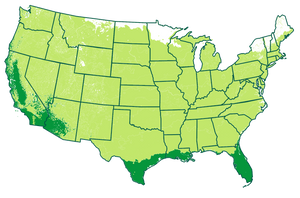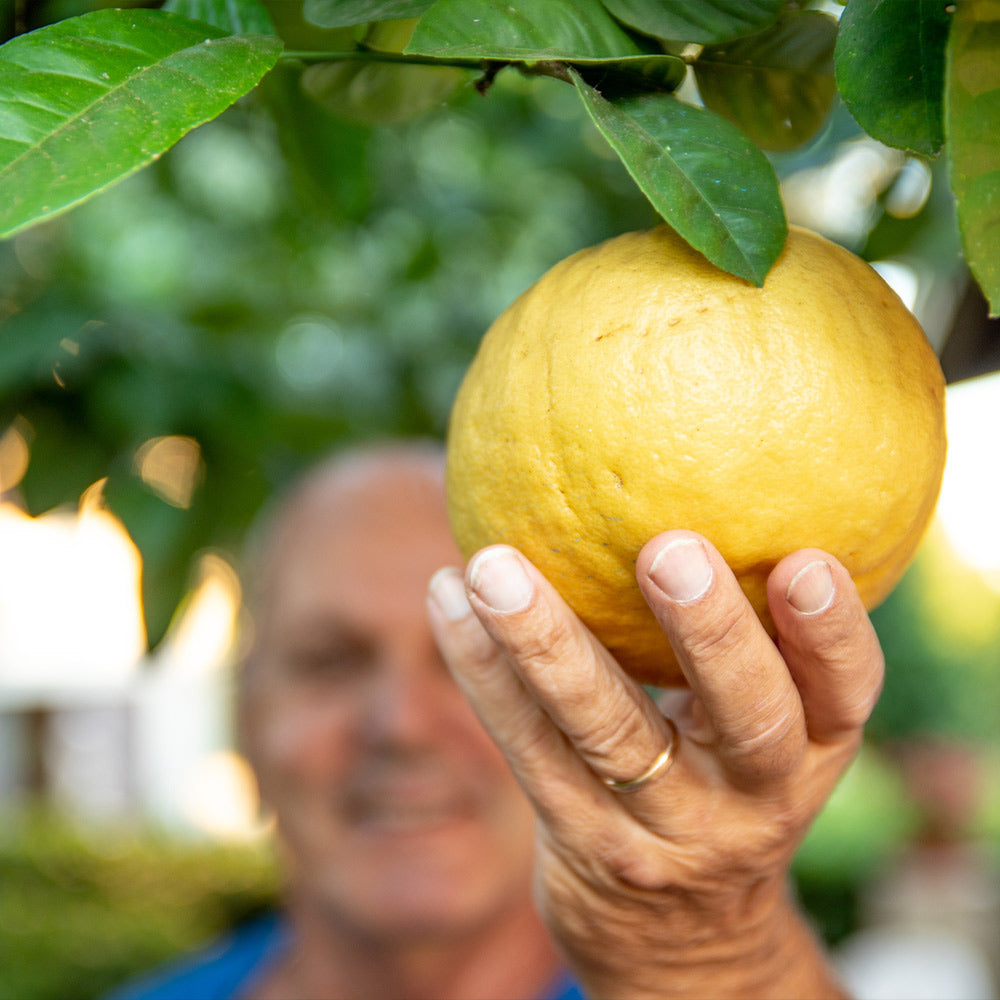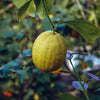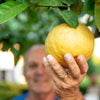* Images shown are of mature plants

Have questions? Talk with our Plant Experts (800) 973-8959
Save 25% on $200+ with code FALL25.
Questions? Call our plant experts: (800) 973-8959
Get Extremely Large Harvests of Super-Sized Lemons
You’ll Have Grapefruit-Size Lemons All Year Long
The Ponderosa Lemon is a tropical hybrid that produces jumbo-sized lemons. A cross between the citron and the traditional lemon, Ponderosa Lemons reach the size of grapefruits, each one weighing 1 to 2 pounds!
Ponderosas can produce lemons year-round, depending on your climate, but peak harvest seasons are late summer and winter. Planted outside, your tree will reach a height up to 24 feet for those living in zones 9-11. If you reside outside of those zones, you can grow these lemons indoors. Your tree will do well in a container set in front of a sunny window. Just imagine an ample supply of lemons whenever you want them! You’ll have pounds of giant fruit ready to be picked all year long.
You’ll Never Want Another Grocery Store Lemon
The sweet flavor of this lemon will make all your food taste better. You’ll get a lot of juice from each giant lemon, adding more flavor to main courses. Ponderosa Lemons are thick-skinned and their bumpy rind is great for making lemon zest. You’ll also never be without lemon flavoring for cooked vegetables, chicken, and fish! They’re great to have on hand to add that special touch to evening cocktails as well.
Your lemon desserts will taste fresher, as will your frozen treats. You’ll always have enough lemons to make gourmet lemonade by the pitchers-full. (If you’ve never tried lemonade from a Ponderosa, prepare to be delighted!)
Each Ponderosa Lemon is also full of Calcium, Fiber, Iron, Vitamin C, and essential Antioxidants. With lots of home-grown lemons at your beckon, start looking forward to more, flavorful, vitamin-rich dishes.
Enhance Your Property with a Tropical Display of Flowers and Fruit
The Ponderosa Lemon possesses a very uncommon trait. It bears fruit and flowers simultaneously. It’s hard to find a showier accent plant when you consider the beautiful white blooming flowers that are tinged with purple - alongside bright yellow lemons. Ponderosa Lemons remain on the tree for many months without deteriorating, so you won’t feel rushed to pick them. You’ll always be able to see lemons on your tree.
A Clever Way to Reinvent Your Living Space.
The Ponderosa Lemon is an excellent indoor grower because it is not fussy about soil type, doesn’t mind extensive pruning, and does well in containers. Your adaptable, tropical companion will travel seamlessly from the patio to indoors. The blooms are very fragrant, and since the Ponderosa Lemon blooms and produces fruit at the same time, you’ll get a tantalizing mix of fragrances. The sublime scent of its flowers blends with the sweetness of the lemons to release a fresh, floral aroma like no other fruit tree.
Order Now to get Ponderosa Lemons the very first season.
Pollination Info
Ponderosa Lemon Pollination
Ponderosa Lemons are self-fertile. You will get fruit with only one plant. However, adding an additional Ponderosa Lemon will drastically increase the size of your crop.
Planting & Care
Seasonal, Location, and Exposure Considerations:
The Ponderosa Lemon, a hybrid of a lemon and a citron, has minimal cold tolerance. Of all the citrus, Lemons are the least hardy against cold. Limit outside culture to only Zones 9-11. They are most successfully grown in California, Texas, and Florida.
Soil Preferences
Your Ponderosa is very tolerant of poor soil, but they require good drainage. Their preferred pH range is 5.5-6.5. Organic matter provided by mulches and compost help retain moisture for your Lemon tree, and in the process of breaking down, give it a steady supply of the major nutrients.
Planting and Care – Container Grown or in Pots
In all zones colder than Zone 9, plan to grow your Ponderosa Lemon indoors. Select a container that is one size larger than the container it came in. Clay pots are recommended as they help drain the pot better, and allow for good air exchange within the pot. Your new potting mix should primarily contain a drainage aggregate and some organic matter. A good mix would contain equal parts of perlite, vermiculite, peat, and sterilized potting soil. Adding in some well matured compost as a portion of the peat component would have good results, though not necessary.
The top of the soil surface should be about an inch below the lip of the container so as to prevent overspill and enable even watering.
Fill your pot about 1/3 with your new soil mix, and set your tree so that the soil level in the container you bought is about an inch below the top lip of the pot. Water the soil in and around the tree to settle it around the roots, then continue filling. Water thoroughly and evenly after planting, but do not saturate the soil to a point where it is ‘soggy’.
In future waterings, wait until the surface of the soil is dried out to about an inch or two to the touch. You may find that your container Lemon Tree may require frequent waterings, as many as 1-2 times per day. During the heat of the summer, allow the surface of the soil to dry out before watering. In the winter, the surface soil will not dry out as readily. Never allow your Lemon to be rooted in soggy soil.
Your Ponderosa also needs humidity. One way to provide this is to have your container set inside a tray or larger (but shallow) container and cover the bottom of the tray with clean pebbles or small washed stone. Then set your container Lemon on top of the pebbles. Add water to the tray to almost cover the stone. Do not allow the Lemon Tree container to sit in water.
Use a liquid fertilizer specifically formulated for Citrus. When the tree is actively growing, feed according to label, twice monthly. In the winter, cut back fertilizer to once a month. Follow dilution recommendations closely.
Your indoor Ponderosa should be pruned before new growth initiates in the early spring. Always use clean and sharp tools. Remove crossing branches, and aim for an open, strong canopy to allow for good air circulation. Make your branch cuts all the way back to the originating shoot. To control overall growth, you can snip the tips of canopy growth by several inches once your tree is established and in the desired form. Remove low growing shoots below the lowest primary branches. You can remove damaged or dead shoots anytime during the year. You can also snip off erratic, long, or undesirable tips as you see them.
Once sustained temperatures drop below 50oF, bring your Ponderosa indoors. Choose a brightly lit room, keeping it near a sunny window, and away from drafts. Ideal indoor temperatures for indoor citrus is around 65F during the day; and night time temperatures about 55-60F.
When returning your Ponderosa in the spring, do so in a manner to acclimate it slowly over a week or two. Do not begin this process until night time temperatures are consistently above 55F. When first taking out, place in a warm, but shady spot during the day; and then bring it inside for several days. Then expose to bright morning sun, moving to a shady area in the afternoon, then leave it outside for the next few days. After this point, you can give it the desired full sun location.
Lemon trees love humidity. Mist the leaves with a water spray daily, especially in warm dry indoor conditions and the heat of summer.
Hand pollination of your Ponderosa is necessary to bear fruit. Use a small paint brush and rub the pollen within the flower to pollinate.
Planting and Care – Outdoor Growing in the Garden
Air circulation is important for Ponderosa Lemon. Choose sites that are at least 25-30 feet from any structures or other trees. A location allowing protection from colder winds (north) is best. Full sun, all day, is ideal.
Remove all weeds, trash, sod, etc to a 2’ diameter around the area where you are planting the tree.
Your hole should be the same depth and twice the width of the pot in which the tree came. Gently lift the tree out of the container, and use a gentle stream of water to rinse away the soil covering the outer roots of the ball.
Backfill the hole about halfway with your soil mix. Fill the hole with water and allow it to leach through, filling air spaces around and under the roots. Once drained, finish filling, water again thoroughly, and top off with soil, mounding the soil slightly around the base of the trunk and pack the last fill of soil well. Form a moat of about 3” high, and 8” wide at a circumference of about 2’ away from the tree.
Fill your moat right after planting, and then again at 3 day intervals for the first two weeks of establishment. In time, the moat will work its way into the soil. After the first couple weeks, water weekly.
Mulch well with an organic mulch. Spread your mulch out to the dripline of the tree, at a depth of 3-4”, but keep the mulch about 12” away from the trunk of the tree to discourage disease, insects, and small rodents from damaging the base. Renovate your mulch each spring. Shallowly working in the mulch layer closest to the soil that has begun to rot down provides some organic matter, then apply your new mulch over it.
Watering
See guidelines above for watering indoor Ponderosa. For outdoor plantings, water to an imaginary line about 12” past the dripline, all the way into the trunk. Soak thoroughly, evenly, slowly, and deeply. Salts are not good for the roots, and watering thoroughly helps leach them out of the rooting zone. Maintain a ‘moist’ soil, but do not allow it to become soggy. New plantings need frequent watering, every 2-3 days usually for the first 4-6 weeks. After that point, you can water every 3-6 days depending on the ‘feel’ of the soil. In the Tree’s first year, you should anticipate watering 2-3 times weekly, then dropping back to every week or two in the fall and winter. Water less frequently when rain events provide good water. In its second year, your intervals will drop to 1-2 per week in the summer, and 2-3 weeks in the winter. Add a week of interval once the trees are 3 years and older. These are guidelines. Let your weather and the ‘feel’ of the soil be your guide.
Fertilizing
Though not terribly high maintenance regarding fertility, your Ponderosa will give you a nice response when you fertilize the newly planted tree with about 1/3 cup of 21-0-0 (ammonium sulfate) after new growth appears in April-May. Scatter the fertilizer evenly through the rooting zone of the tree out to the dripline and water it in thoroughly. Repeat this application once between August-September. Do not over fertilize.
In the second and later years, apply fertilizer in January through February; April through May; and August through September (3 times per year). In the second year, use 2 cups per year of 21-0-0 evenly divided among the three application. In the third through the seven or eight year old tree, increase to 4 cups spread across the three applications per year.
Weed, Insects, and Diseases
Keep the area free of weeds at all times, weeding manually. Aphids and scale insects are the most common insect pests for “Ponderosa”. You can keep them at bay by blasting with a strong spray from your water hose. There are insecticidal soaps and horticultural oils labelled for controlling these and other insects for indoor plants or if the water hose isn’t effective in outdoor plantings.
Consult local sources for information regarding diseases that might occur. Never subject the roots to waterlogged conditions, and maintain good humidity for the leaves; and you’ll go a long way to keep your tree healthy and resistant to disease.
Pruning and Training
Before active growing in the spring, remove any dead or damaged limbs. Remove any shoots or suckers that emerge below the lowest limbs of the trunk. See comments in the Containers Section above regarding shaping and encouraging air circulation.
Other
Freezing temperatures will ruin the fruit so pick all the ripe lemons before a predicted frost in your region.
Freezing temperatures will kill this very tender citrus tree. Protect with several layers of cardboard wrapped around the lowest limbs, and all the way to the ground. You can secure the cardboard using duct tape. You can drape old blankets over the tree as well. The idea is to keep the tree covered from top to bottom and retain warm air close to the tree. There are other methods as well. Regardless, when covering the tree, remove the cover once temperatures rise, and replace it when a frost is expected.
Shipping Details
Estimated Shipping Time: Most orders ship immediately. As noted on the website, some items are seasonal, and may only ship in spring or fall. Once your order is shipped, you'll receive an email with a tracking number.
| Amount of Order | Shipping Charge |
|---|---|
| Less than $49 | $19.95 |
| $49 + | FREE SHIPPING! |
Product Details
| Mature Height: | 12-24 ft. |
| Mature Width: | 10-12 ft. |
| Sunlight: | Full-Partial |
| Growth Rate: | Moderate |
| Harvest Time: | Late Summer & Winter |
| Year to Bear: | Can Fruit the 1st year! |
| Botanical Name: | Citrus x limon 'Ponderosa' |
| Does Not Ship To: | AL,AZ,CA,FL,GA,LA,OR,TX |
| Grows Well In Zones: | 4-11 patio / 9-11 outdoors |
| Your Growing Zone: | # |







